Question
Match the following columns. [NEET (Sep.) 2020]
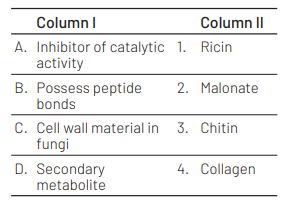
Choose the correct option.
$
A \text { B B C D }
$
(a) $3 \quad 1 \quad 4 \quad 2$
(b) $\begin{array}{lllll}3 & 4 & 1 & 2\end{array}$
(c) $\begin{array}{llll}2 & 3 & 1 & 4\end{array}$
(d) $2 \quad 4 \quad 3 \quad 1$
Answer/Explanation
Ans. (d)
Option (d) is the correct. It can be explained as follows. Malonate is the competitive inhibitor of catalytic activity of succinic dehydrogenase. Collagen is proteinaceous in nature and possesses peptide bonds. Chitin is a homopolymer present in the cell wall of fungi and exoskeleton of arthropods. Abrin and ricin are toxins, secondary metabolites.
Question
Prosthetic groups differ from coenzymes in that [NEET (Odisha) 2019]
(a) they require Gmetal ions for their activity
(b) they (prosthetic groups) are tightly bound to apoenzymes
(c) their association with apoenzymes is transient
(d) they can serve as cofactors in a number of enzyme catalysed reactions
Answer/Explanation
Ans. (b)
Prosthetic groups are organic compounds and are distinguished from other cofactors in that they are tightly bound to the apoenzyme. For example; in peroxidase and catalase, which catalyse the breakdown of hydrogen peroxide to water and oxygen, haem is the prosthetic group and it is a part of the active site of the enzyme.
Question
Which of the following is a commercial blood cholesterol lowering agent? [NEET (National) 2019]
(a) Statin
(b) Streptokinase
(c) Lipases
(d) Cyclosporin A
Answer/Explanation
Ans. (a)
Statins are commercial blood cholesterol lowering agent as they competitively inhibit the enzymes involved in cholesterol synthesis. They are obtained from a yeast, Monascus purpureus.
Streptokinase is a thrombolytic agent. which is used to treat pulmonary embolism and myocardial infarction. Lipases help to digest fat molecules while cyclosporin $A$ is an immunosuppressant.
Question
Consider the following statement [NEET (National) 2019]
(A) Coenzyme or metal ion that is tightly bound to enzyme protein is called prosthetic group.
(B) A complete catalytic active enzyme with its bound prosthetic group is called apoenzyme. Select the correct option.
(a)(A) is true but $(B)$ is false
(b) Both (A) and (B) are false
(c) $(A)$ is false but $(B)$ is true
(d) Both (A) and (B) are true
Answer/Explanation
Ans. (a)
Statement $A$ is true but $B$ is false. Correct information about statement B is as follows.
A complete catalytic, active enzyme with its bound prosthetic group is called holoenzyme. An apoenzyme is an inactive enzyme which gets activated by the binding of an organic or inorganic cofactor.
Question
Select the correct match [NEET 2018]
(a) THMorgan – Transduction
(b) $\mathrm{F}_2 \times$ Recessive parent $-$ Dihybrid cross
(c) Ribozyme – Nucleic acid
(d) G Mendel – Transformation
Answer/Explanation
Ans. (c)
Ribozymes are RNA molecules having enzymatic activity, i.e. they are capable of catalysing specific biochemical reactions. Hence, they are nucleic acids with enzymatic function.
TH Morgan is known as the ‘Father of Experimental Genetics’. He worked on linkage, crossing over, linkage maps, etc.
In dihybrid cross, two allelic pairs are used for crossing. Mendel is considered as the ‘Father of Genetics. He proposed the laws of inheritance.
Question
Which one of the following statements is correct, with reference to enzymes? [NEET 2017]
(a) Apoenzyme = Holoenzyme $+$ Coenzyme
(b) Holoenzyme =Apoenzyme $+$ Coenzyme
(c) Coenzyme =Apoenzyme $+$ Holoenzyme
(d) Holoenzyme $=$ Coenzyme $+$ Cofactor
Answer/Explanation
Ans. (b)
Holoenzyme it is a conjugate catalytically active enzyme together with its coenzyme. Apoenzyme The protein part of catabolically active enzyme is called apoenzyme. Coenzyme Some enzymes require additional organic or metallo-organic molecules for their activity. These molecules are called coenzyme.
So, holoenzyme is apoenzyme together with coenzyme hence option (b) is correct.
Question
Which of the following describes the given graph correctly? [NEET 2016, Phase II]
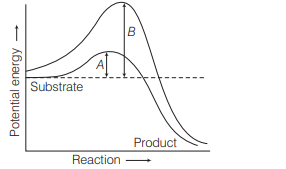
(a) Endothermic reaction with energy $A$ in the presence of enzyme and $B$ in the absence of enzyme
(b) Exothermic reaction with energy $\mathrm{A}$ in the presence of enzyme and $B$ in the absence of enzyme
(c) Endothermic reaction with energy $A$ in the absence of enzyme and $B$ in the presence of enzyme
(d) Exothermic reaction with energy $\mathrm{A}$ in the absence of enzyme and $B$ in the presence of enzyme
Answer/Explanation
Ans. (b)
The graph shows the exothermic reaction $A$ in the presence of enzyme as it lowers down the activation energy substantially.
The $\mathrm{B}$ graph shows this reaction in the absence of enzyme when activation energy is quite high. Thus, option (b) is correct.
Question
A non-proteinaceous enzyme is [NEET 2016, Phase II]
(a) lysozyme
(b) ribozyme
(c) ligase
(d) deoxyribonuclease
Answer/Explanation
Ans. (b)
Ribozyme is a form of ribosomal RNA (23 SrRNA) which acts as a catalyst in splicing of RNA during protein synthesis. It is the only non-protein enzyme known so far, rest all the enzymes are proteinaceous. Hence, option (b) is correct.
Question
Select the option which is not correct with respect to enzyme action. [CBSE AIPMT 2014]
(a) Substrate binds with enzyme as its active site
(b) Addition of lot of succinate does not reverse the inhibition of succinic dehydrogenase by malonate
(c) A non-competitive inhibitor binds the enzyme at a site distinct from that which binds the substrate
(d) Malonate is a competitive inhibitor of succinic dehydrogenase
Answer/Explanation
Ans. (b)
Option (b) is incorrect with respect to enzyme action because addition of a lot of succinate reverse the inhibition of succinic dehydrogenase by malonate. Inhibition of succinic dehydrogenase by malonate is an example of competitive inhibition.
Competitive inhibition occurs when enzyme and inhibitor both have more or less similar structure and are present in higher concentration.
Thus, both enzyme and inhibitor compete for the active site of enzyme resulting in the decrease of the enzymatic activity.
Question
Transition state structure of the substrate formed during an enzymatic reaction is [NEET 2013]
(a) transient but stable
(b) permanent but unstable
(c) transient and unstable
(d) permanent and stable
Answer/Explanation
Ans. (c)
The substrate binds to the enzyme at its active site forming an enzyme substrate complex. This complex formation is a transient and unstable phenomenon. Very soon, the product is released from the active site. It is the fact that all other intermediate structural states are unstable.
Stability is related to energy status of the molecule or the structure.
Question
The essential chemical components of many coenzymes are [NEET 2013]
(a) proteins
(b) nucleic acids
(c) carbohydrates
(d) vitamins
Answer/Explanation
Ans. (d)
Essential chemical components of many coenzymes are vitamins, e.g. coenzyme Nicotinamide Adenine Dinucleotide (NAD) and NADP contain the vitamin niacin. Proteins, nucleic acids and carbohydrates are not enzymatic biomolecules.
Question
The curve given below shows enzymatic activity with relation to three conditions ( $\mathrm{pH}$, temperature and substrate concentration). [CBSE AIPMT 2011]
What do the two axis ( $X$ and $Y$ ) represent?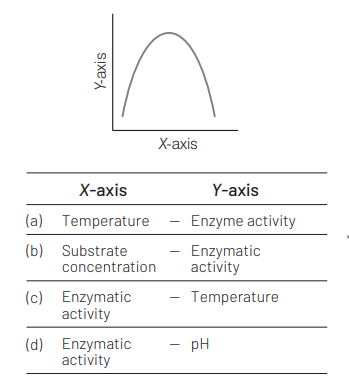
Answer/Explanation
Ans. (a)
$X$-axis represents temperature and $Y$-axis represent enzyme activity. All enzyme act at an optimum temperature, above and below this temperature, the enzyme activity declines.
Question
Modern detergents contain enzyme preparation of [CBSE AIPMT 2008]
(a) acidophiles
(b)alkaliphiles
(c) thermoacidophiles
(d) thermophiles
Answer/Explanation
Ans. (b)
Modern detergents contains enzyme preparation of alkaliphiles. Detergents represent the largest industrial application of enzymes amounting to $25-30 \%$ of total sales of enzyme.
The enzymes used in detergents must be cost effective, safe to use and be able to perform the task in the presence of anionic and non-ionic detergents, soaps, oxidants, etc at $\mathrm{pH}$ between $8-10.5 \%$.
The chief enzymes used are proteases, $\alpha$-amylase and sometimes cellulase.
Question
A competitive inhibitor of succinic dehydrogenase is [CBSE AIPMT 2008]
(a) malonate
(b) oxaloacetate
(c) $\alpha$-ketoglutarate
(d) malate
Answer/Explanation
Ans. (a)
Succinic dehydrogenase oxidised the succinate to fumarate. Malonate, an analogue of succinate, which is a strong competitive inhibitor af succinate dehydrogenase and therefore, blocks the activity of citric acid cycle in eukaryotes.
In Krebs’ cycle the reversible hydration of fumarate to malate is catalysed by fumarase enzyme.
Question
An organic substance bound to an enzyme and essential for its activity is called [CBSE AIPMT 2006]
(a)holoenzyme
(b) apoenzyme
(c)isoenzyme
(d) coenzyme
Answer/Explanation
Ans. (d)
Coenzyme is an organic non-protein molecule that associates with an enzyme molecule in catalysing biochemical reactions. It usually participates in the substrate enzyme interaction by donating or accepting certain chemical groups.
Holoenzyme is a complex comprising of enzyme molecule and its cofactor. The enzyme is catalytically active in this state.
Apoenzyme is an inactive enzyme that must associate with a specific cofactor molecule in arder to function. Isoenzyme or isozyme is one of the several forms of an enzyme that catalyse the same reaction but differ from each other in such properties as substrate affinity and maximum rates of enzyme substrate reaction.
Question
An enzyme that can stimulate germination of barley seeds is [CBSE AIPMT 2006]
(a) -amylase
(b) lipase
(c) protease
(d) invertase
Answer/Explanation
Ans. (a)
Barley seeds are rich in carbohydrate (starch). The starch is hydrolysed by $\alpha$-amylase to monosaccharides unit at the time of germination of seeds.
Question
Which one of the following hydrolyses internal phosphodiester bonds in a polynucleotide chain? [CBSE AIPMT 2005]
(a) Lipase
(b) Protease
(c) Endonuclease
(d) Exonuclease
Answer/Explanation
Ans. (c)
DNase (deoxyribonuclease) or simply nuclease is an enzyme which breaks down DNA by hydrolysis af the phosphodiester bonds of its sugar-phosphate back bone. Depending on the position of hydrolysing phosphodiester bonds, nucleases are of two types:
(i) Endonucleases
(ii) Exonucleases
Endonucleases hydrolyse internal phosphodiester bonds in a polynucleotide chain (i.e. DNA). While exonucleases hydrolyse terminal phosphodiester bonds in a polynucleotide chain (i.e. DNA).
Question
Which of the following statements regarding enzyme inhibition is correct? [CBSE AIPMT 2005]
(a) Competitive inhibition is seen when a substrate competes with an enzyme for binding to an inhibitor protein
(b) Competitive inhibition is seen when the substrate and the inhibitor compete for the active site on the enzyme
(c) Non-competitive inhibition of an enzyme can be overcome by adding large amount of substrate
(d) Non-competitive inhibitors often bind to the enzyme irreversibly
Answer/Explanation
Ans. (b)
A competitive inhibitor competes with substrate molecule for occupying the active site of an enzyme. These inhibitors have structural resemblance with substrate molecules due to which they easily bind with active site of an enzyme and form an enzyme-inhibitor complex.
Question
Enzymes, vitamins and hormones can be classified into a single category of biological chemicals, because all of these [CBSE AIPMT 2005]
(a) help in regulating metabolism
(b) are exclusively synthesised in the body of a living organism as at present
(c)are conjugated proteins
(d) enhance oxidative metabolism
Answer/Explanation
Ans. (a)
Enzymes, vitamins and hormones are classified into a single category of biological chemical because all these help in regulation of metabolism. Enzyme is a proteinaceous catalyst produced by a cell and responsible for the high rate and specificity of one or more intercellular or intracellular biochemical reactions. Vitamin is an organic substance which generally synthesised by plants (exception vitamin-D). Absence of a vitamin from the diet for sufficient time gives symptoms of a resulting deficiency disease. Hormones are chemical messengers which on secretion bring about a specific and adaptive physiological response.
Question
The catalytic efficiency of two different enzymes can be compared by the [CBSE AIPMT 2005]
(a) formation of the product
(b) $\mathrm{pH}$ optimum value
(c) $K_m$ value
(d) molecular size of the enzyme
Answer/Explanation
Ans. (c)
$K_m$, Michaelis-Menten constant is defined as substrate concentration at which reaction velocity of enzyme catalysed reaction $\left(V_0\right)$ is half of the maximum velocity of this reaction $\left(V_{\max }\right)$ , (i.e. $K_m=1 / 2 V_{\max }$ J. $K_m$ can vary greatly from enzyme to enzyme and even for the different substrates of the same enzyme.
Question
The major role of minor elements inside living organisms is to act as [CBSE AIPMT 2003]
(a) binder of cell structure
(b) cofactors of enzymes
(c) building blocks of important amino acids
(d) constituent of hormones
Answer/Explanation
Ans. (b)
Though trace elements are required for various uses, most of these have a significant role in enzyme activities(e.g. zinc activates carboxylases, carbonic anhydrase and various dehydrogenases).
Question
Hydrolytic enzymes which act at low $\mathrm{pH}$ are called as [CBSE AIPMT 2002]
(a) proteases
(b) $\alpha$-amylases
(c) hydrolases
(d) peroxidases
Answer/Explanation
Ans. (c)
Lysosames are the reservoirs of acid hydrolases showing optimum activity at pH $5.0$ maintained within the lysasome. These include proteases, nucleases, glycosidases, lipase, etc. Among these protease act a very low $\mathrm{pH}$, i.e. 2 .
Question
Cytochrome is [CBSE AIPMT 2001]
(a) metallo flavoprotein
(b) Fe containing porphyrin pigment
(c)glycoprotein
(d) lipid
Answer/Explanation
Ans. (b)
Cytochrome is the respiratary pigment.
It is composed of protein, iron and porphyrin ring. It functions as an enzyme in the respiratory chain. Unlike haemoglobin the metal atom in the porphyrin ring must change it’s valency for the molecule to function.
Cytochromes are basically located in inner mitochondrial membranes and thylakoids af chloroplasts.
Question
Enzymes enhance the rate of reaction by [CBSE AIPMT 2000]
(a) forming a reactant-product complex
(b) changing the equilibrium point of the reaction
(c) combining with the product as soon as it is formed
(d) lowering the activation energy of the reaction
Answer/Explanation
Ans. (d)
Enzymes enhance the rate of a reaction by just lowering the activation energy (the energy required for substances to react and get converted into product) of a reaction.
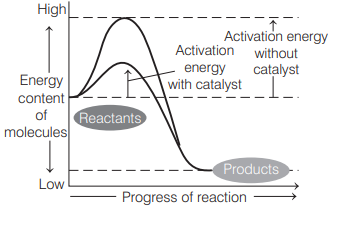
Question
Feedback inhibition of an enzymatic reaction is caused by [CBSE AIPMT 2000]
(a) end product
(b) substrate
(c) enzyme
(d) rise in temperature
Answer/Explanation
Ans. (a)
In feedback inhibition, the product of an enzyme-catalysed reaction accumulates and acts as inhibitor of the reaction.
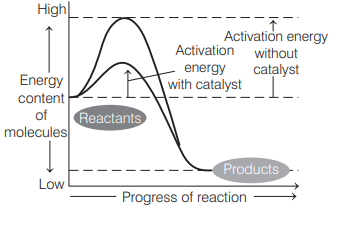
Question
Feedback inhibition of an enzymatic reaction is caused by[CBSE AIPMT 2000]
(a) end product
(b) substrate
(c) enzyme
(d) rise in temperature
Answer/Explanation
Ans. (a)
In feedback inhibition, the product of an enzyme-catalysed reaction accumulates and acts as inhibitor of the reaction.
Question
Cofactor (coenzyme) is a part of holoenzyme it is [CBSE AIPMT 1997]
(a) loosely attached inorganic part
(b) accessory non-protein substance attached firmly
(c) loosely attached organic part
(d) None of the above
Answer/Explanation
Ans. (c)
Coenzyme/cofactors are organic substances (often vitamins) which are loosely attached with apoenzymes. A holoenzyme is a conjugated enzyme. It has a proteinaceous part called apoenzyme and a non-proteinaceous part called cofactor.
Question
An enzyme brings about [CBSE AIPMT 1993]
(a) decrease in reaction time
(b) increase in reaction time
(c) increase in activation energy
(d) reduction in activation energy
Answer/Explanation
Ans. (d)
Enzymes act by reducing the amount of activation energy. The binding energy is the source of energy used by enzyme to lower the activation energy of reaction. Activation energy is the minimum energy required from outside to overcome the energy barrier of reactants. Enzymes lower energy of activation by two ways-bringing reactants molecules together, and developing strain in bonds of reactants.
Question
Enzymes having slightly different molecular structure but performing identical activity are [CBSE AIPMT 1991]
(a) homoenzymes
(b) isoenzymes
(c) apoenzymes
(d) coenzymes
Answer/Explanation
Ans. (b)
Isoenzymes (analogous enzymes) are multiple molecular forms of same enzyme with same substrate activity and found in the same organism. These enzymes are formed by different genes, have different $K_m$ constants for their substrates and operate at different $\mathrm{pH}$. About 100 enzymes are known to have isoenzymes, e.g. LDH
(Lacto-Dehydrogenase acting on pyruvate to form lactate) has 5 isoenzymes in man, $\alpha$-amylase in wheat has 16 isoenzymes.
Question
Which of the following is not a part of enzyme but it activates the enzyme? [CBSE AIPMT 1989]
(a) $\mathrm{K}$
(b) $\mathrm{C}$
(c) $\mathrm{N}$
(d) $\mathrm{Si}$
Answer/Explanation
Ans. (a)
Potassium $\left(\mathrm{K}^{+}\right)$is an essential element, loosely held to the apoenzyme part of the enzyme. $\mathrm{K}^{+}$is an inorganic cofactor (metal activator) of enzyme pyruvate kinase.
